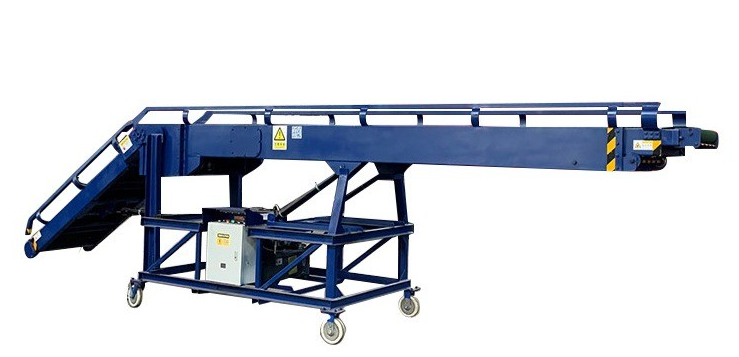Conveyors are essential components in material handling across various industries, including manufacturing, warehousing, and logistics. As businesses demand greater efficiency in moving products and materials, conveyors, particularly telescopic loading conveyors, have become increasingly popular for their versatility and ability to handle large loads over extended distances. Understanding how much a conveyor costs per foot involves considering multiple factors, from the type of conveyor system to its specific application. In this article, we’ll take an in-depth look at these factors, specifically focusing on telescopic loading conveyors and their unique cost considerations.

What Influences the Cost of a Conveyor?
The cost of a conveyor per foot can vary widely depending on a variety of factors, including:
- Type of Conveyor: Conveyors come in various forms, such as belt conveyors, roller conveyors, chain conveyors, and telescopic loading conveyors. The type of conveyor chosen has a significant impact on cost. For example, telescopic loading conveyors are more specialized and versatile, designed to extend and retract as needed, which can add to their price.
- Materials Used: The materials used for the conveyor belt and framework also influence the price. Steel conveyors, for example, tend to be more expensive than those made from lighter materials such as aluminum. Stainless steel conveyors, especially those used in industries like food processing, can be even more expensive due to their corrosion resistance.
- Length and Size: Larger conveyor systems with greater lengths will naturally cost more. Telescopic loading conveyors, which are designed to extend to accommodate different loading and unloading requirements, may be priced higher due to their mechanical and structural complexity.
- Additional Features: Specialized features like adjustable speed control, motorized rollers, or automation features increase the cost. In the case of telescopic loading conveyors, advanced automation features that extend or retract the system to match the truck or container being loaded or unloaded will add to the price.
- Customization: Custom-built systems, such as those designed for specific industries or material types, will cost more due to the engineering and design involved. Telescopic loading conveyors often come with customizable features, which can further increase the price.
- Manufacturing and Installation Costs: The cost of manufacturing the conveyor system and its installation should also be taken into account. Conveyor systems often require professional installation and, in some cases, on-site modifications to meet the specific needs of the business or application.
Average Cost of Telescopic Loading Conveyors
When discussing telescopic loading conveyors, it’s important to note that the price is typically higher than that of fixed conveyors due to the complex mechanical systems involved. Telescopic conveyors are designed to extend and retract, which makes them ideal for applications where loading or unloading space is variable or confined.
Breakdown of Costs:
- Basic Telescopic Loading Conveyor: The cost of a basic telescopic loading conveyor system can range from $500 to $1,500 per foot, depending on the size, features, and materials used.
- High-End Systems: For more advanced systems with motorized control, automation, or heavy-duty design, prices can range from $2,000 to $5,000 per foot.
This price range may include components such as a motor, drive system, and controls. Additional features, like integrated conveyors for package sorting, can increase the cost even further.
Factors That Affect the Cost of Telescopic Loading Conveyors
Application-Specific Needs
Telescopic loading conveyors are often used in industries where quick loading and unloading are critical, such as in logistics and e-commerce. The cost will vary depending on whether the system is being used for:
- Package Handling: For warehouses or shipping companies that handle packages of various sizes, telescopic loading conveyors must be adjustable to accommodate different package types. The design and materials involved here contribute to a higher price.
- Bulk Material Handling: Telescopic conveyors used for bulkier materials may require a sturdier build to handle the weight, and this can drive up the cost of the system.
- Food or Pharmaceutical Industries: For industries requiring strict hygiene standards, the use of stainless steel or corrosion-resistant materials may raise the price due to additional design and material requirements.
Conveyor Length and Width
Telescopic conveyors can be designed in varying lengths and widths, and the dimensions significantly affect the cost per foot. Longer systems with the ability to extend over greater distances will cost more due to their complex mechanical structures. The width of the conveyor also impacts cost, as wider systems require more material and additional reinforcement.
Motorization and Automation
For businesses that require fully automated loading and unloading systems, the cost of telescopic loading conveyors increases significantly. Automated conveyors with sensors, adjustable speeds, and motorized components allow for faster and more efficient material handling but come with a higher price tag.
Long-Term Investment: Durability and Maintenance
Although the initial cost of a telescopic loading conveyor can seem high, the long-term savings and benefits should not be overlooked. Quality systems can last many years with minimal maintenance, reducing overall operating costs. Regular servicing and occasional replacement of parts like the belt or motor will be necessary, but this can be factored into the overall cost of ownership.
Conclusion: Is It Worth the Cost?
Investing in telescopic loading conveyors can provide significant benefits in terms of flexibility, speed, and efficiency in handling materials. The higher initial cost is balanced by the increased productivity and reduced labor costs over time. For businesses that need dynamic loading and unloading solutions in fast-paced environments, telescopic loading conveyors are an excellent option, justifying their cost per foot.
Final Thoughts:
The cost of a conveyor system, particularly telescopic loading conveyors, will depend on several factors including the application, length, and features. While the price range can vary widely, businesses should weigh the benefits of speed, flexibility, and efficiency against the cost when deciding on the right conveyor system for their needs. By understanding the factors involved, you can make an informed decision about your next conveyor purchase.




Comments